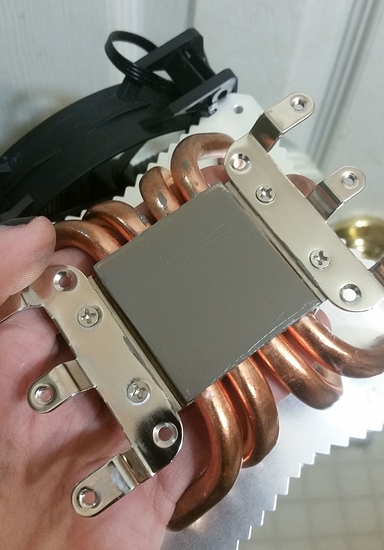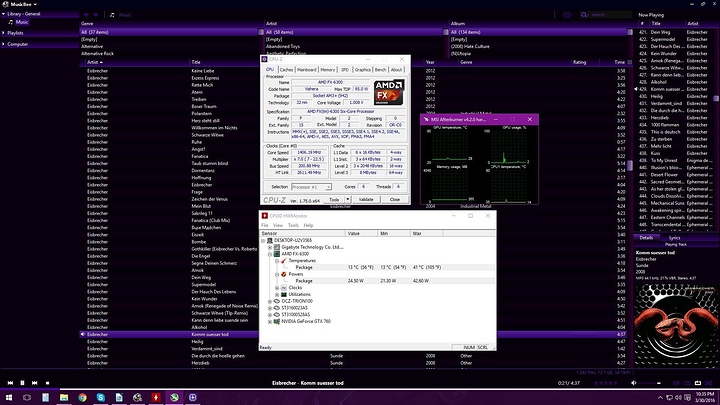Some technical problems put me in the mood to do some general mantainence/cleaning on le ol' case, including dimm reoranging and mobo dusting. This required me to take of my monster of a heatsink and I had no paste; so this was an excuse to try this bulk buy thermal paste I had been eyeballing for months. I baby my hardware as far as temperatures go so later decided to go ahead and get a syringe of Arctic Silver 5 and use this as an excuse to do some data analysis for you guys. Following are the results of some testing. Enjoy.
Hardware:
- Mobo: Gigabyte ga-990fxa-ud5
- CPU: AMD FX-6300 overclocked to 4.5GHz at a max voltage of 1.464 (+.174 over stock, if I remember correctly)
- CPU cooler: Be Quiet! Shadow Rock 2 -- View here: http://www.newegg.com/Product/Product.aspx?Item=9SIA68V21E0641
- RAM: ugh... something something GSkillz 16GB at... 1600Mhz?
- GPU: GTX-760 4GB edition
- PSU: Thermaltake Toughpower simi modular 750W 80+ Gold
- Windows 10 (albeit hacked enough to be mine)
The two pastes compaired:
Cooler Master Ice Fusion
http://www.newegg.com/Product/Product.aspx?Item=N82E16835103080
vs.
Arctic Silver 5
http://www.newegg.com/Product/Product.aspx?Item=N82E16835100008&cm_re=arctic_silver_5-_-35-100-008-_-Product
Method of paste application:
That is a VERY thin (thinner than the factory applications you see on stock coolers) layer of paste that I apply to both the processor and heatsink. Some people find this to be a waste of time, but I always get good results out of doing this.
Method of testing:
I took note of average temperatures and any spikes that may be significant while playing a few games normally. By "spikes" I am referring to temperature increases that happen at the same time as sudden lag or otherwise reduced visual performance. Otherwise, I paid special attention to how much the temperature fluctuates (that don't corelate to lag spikes) and I will rate these as follows:
- none/no - temperature fluctuations that do not exceed 2C
- mild - temperature fluctuations that average 5C
- moderate - temperature fluctuations that average 7-10C
- much - temperature fluctuations that exceed 12C
EDIT NOTICE: by temperature fluctuations, I mean BOTH POSITIVE AND NEGATIVE. So if an average was 50 with a fluctuation of "mild" that means it got down to 45 sometimes, not just getting up to 55. What I mean by 'average temperature" is the most common average between these highs and lows. Should have clarified this earlier.
Unless otherwise specified, every test was done with absolute max settings in the applications listed at 1080p resolution.
EDIT NOTICE: To clarify, the room temperature was roughly the same during the times of testing and increased temperature over time would have not been a major factor due to enough airflow through the house (i.e. I didn't "hotbox" test with my room closed off, getting warmer over time). Sadly I can't control for variables any closer than that at the time due to not having fancy pants equipment.
Temperatures:
Path of Exile
Ice Fusion: average of 51C, spikes as high as 72C; much fluctuation
AS5: 45C, average spikes were 55C; mild fluctuation
Difference: about a -7C average
Star Craft 2 (actually playing an arcade game called Special Forces Elite 5, which has tons of units)
Ice Fusion: 63C; mild fluctuation
AS5: 52C; no fluctuation
Difference: -11C average
Guild Wars 2 - A note about how I tested in GW2. As I did not want to spend the time playing it because I haven't' been in the mood, I did not actually go out and do what I normally do. I only went to the in-game PvP lobby, which is notorious for having terrible framerate and having relatively high, standing around/idle temperatures. I only did this to have more diversity in the testing.
Ice Fusion: 52C; mild fluctuation
AS5: 40C; absolutely no fluctuation
Difference: -12C average
Unigine Heaven benchmark (max settings except AA, which is only 2x as higher tortures my poor 760)
Ice Fusion: 57C; moderate fluctuation
AS5: 48C; mild fluctuation
Difference: -9C average
Unigine Valley (max with 8x AA)
Ice Fusion: 60C; moderate fluctuation
AS5: 48C; mild fluctuation
Difference: -12C average
The Elder Scrolls 5: Skyrim (with enough graphics and gameplay mods to convert any console fanboy)
Ice Fusion: 58C indoors, 66C outdoors; moderate fluctuation (indoor or outdoor; more likely outdoor however)
AS5: 42C; moderate fluctuation I just redid the paste tonight so this last bit here on Skyrim is not conclusive. I went to one of the most intensive areas in the game (modded Whiterun exterior) but that does not account for all the unique landscapes and the way they interact with mods.
Difference: presumed -16C average
EDIT NOTICE: I'm clarifying something here because people seem to be getting the impression from the way that I listed the numbers that it was common for the temperatures to average in the mid to high 60s while using the Ice Fusion paste. This is not the case. Star Craft 2 testing was the only test that had consistent temperatures in the 60s, 63c to be exact as listed above (yes, Unigine Valley technically did average "in the 60s" as 60 is, well, in the 60s). Other than that, the only time it got into the 60s or higher was during temperature spikes, such as during Path of Exile. So, to clarify, the overall average (i.e. average across all testing) for the Ice Fusion paste was 58-60C and the overall average for the Arctic Silver 5 is 48C (and that was before the "200 hour set in").
Analysis:
This is very interesting. In all the testing I've ever done, I've seen a trend that suggests that lower temperatures fluctuate more. This experiment falls painfully in line with that trend. There are three things that I believe are responsible for this:
- Dynamic fan speeds that adjust according to core temperature (this one is kinda "duh")
- The mumbo jumbo magic that is thermodynamic laws (in regards to heat moving away from the core)
- Inaccurate readings at lower temperatures
Number 3 is only speculation based on two things: 1-idle temperatures are unrealistic, and 2-it would make sense that core sensors would be optimized at being accurate around the temperature range that the core is expected to operate, which might mean that it is less accurate outside that range. I've seen people comment about how this is probably the case and you can see this in idle temperatures. For example, I sometimes get 9C idle. Nine degrees??? NINE??? That's impossible. That's approaching half my bedroom's current temperature.
With that out of the way, two things to note: Arctic Silver 5 not only keeps the core cooler, it has significantly less temperature fluctuation. I believe this to be showing that there is a great ease of transition for heat from the core to the heatsink, while with the Ice Fusion paste more heat has to be built up for the transition to be smoother.
The Path of Exile and Unigine Valley testing is particularly interesting to me. PoE is notorious for how it was coded: badly. You can get it to run just fine with decent hardware, but the strain is unnecessarily high. In particular, I included running with a few friends that have some VERY laggy builds - the kind of stuff that has caused server crashes. The two main reasons behind such CPU strain in PoE is, I believe, the particle effects and the sound, which of course has to be uncompressed, rendered, etc, and in PoE sound activators can be spammed like mad with multi-target attacks. The particle effects has a similar scenario in Unigine Valley. I noticed the temperature go up and stay up during the rain scenes. Similar things can be said about Skyrim.
Conclusion:
Holy pah! So obviously yes the trend of better paste = cooler temperatures is true, nobody could ever dispute that of course. But what an unexpected turnout! A bit of perspective: I'm putting both pastes under the same pressure here, which is a lot. What gets me is just how well a paste as cheap as the Ice Fusion performed under the circumstances. The hottest it ever got was 75C and that only happened once; otherwise the average high was 72 in Path of Exile testing. That's not bad; really, that's actually pretty damn good! $20 for TWO HUNDRED GRAMS of paste that will perform well enough under these circumstances? If you're a PC builder, this is my recommendation - pick this up.
Of course, I'm still using AS5 on my rig. I baby my things because I can't replace them. But this has been a really interesting experience.



